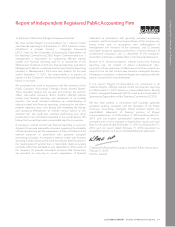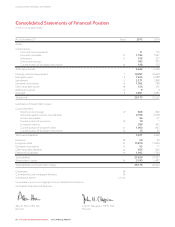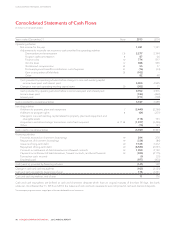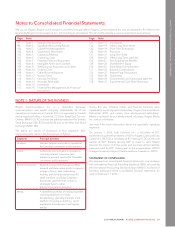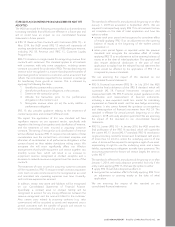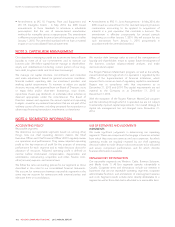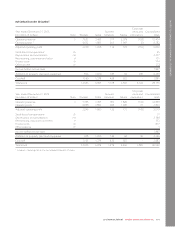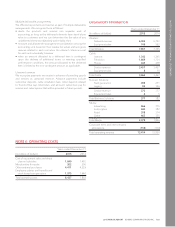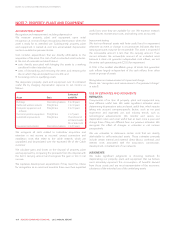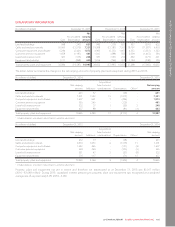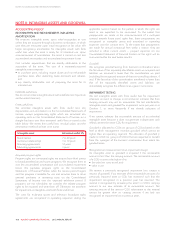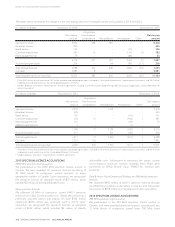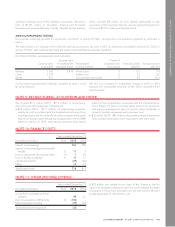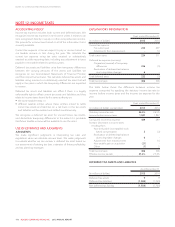Rogers 2015 Annual Report Download - page 102
Download and view the complete annual report
Please find page 102 of the 2015 Rogers annual report below. You can navigate through the pages in the report by either clicking on the pages listed below, or by using the keyword search tool below to find specific information within the annual report.
NOTES TO CONSOLIDATED FINANCIAL STATEMENTS
• Amendments to IAS 16, Property, Plant and Equipment and
IAS 38, Intangible Assets – In May 2014, the IASB issued
amendments to these standards to introduce a rebuttable
presumption that the use of revenue-based amortization
methods for intangible assets is inappropriate. The amendment
is effective prospectively for annual periods beginning on or after
January 1, 2016. The amended standard will not have a material
impact on our consolidated financial statements.
• Amendments to IFRS 11, Joint Arrangements – In May 2014, the
IASB issued an amendment to this standard requiring business
combination accounting to be applied to acquisitions of
interests in a joint operation that constitute a business. The
amendment is effective prospectively for annual periods
beginning on or after January 1, 2016. We will account for any
such transactions from January 1, 2016 prospectively in
accordance with the amended standard.
NOTE 3: CAPITAL RISK MANAGEMENT
Our objectives in managing capital are to ensure we have sufficient
liquidity to meet all of our commitments and to execute our
business plan. We define capital that we manage as shareholders’
equity and indebtedness (including current portion of our long-
term debt, long-term debt, and short-term borrowings).
We manage our capital structure, commitments, and maturities
and make adjustments based on general economic conditions,
financial markets, operating risks, our investment priorities, and
working capital requirements. To maintain or adjust our capital
structure, we may, with approval from our Board of Directors, issue
or repay debt and/or short-term borrowings, issue shares,
repurchase shares, pay dividends, or undertake other activities as
deemed appropriate under the circumstances. The Board of
Directors reviews and approves the annual capital and operating
budgets, as well as any material transactions that are not part of the
ordinary course of business, including proposals for acquisitions or
other major financing transactions, investments, or divestitures.
We monitor debt leverage ratios as part of the management of
liquidity and shareholders’ return to sustain future development of
the business, conduct valuation-related analyses, and make
decisions about capital.
The Rogers Platinum MasterCard program, as well as the wholly-
owned subsidiary through which it is operated, is regulated by the
Office of the Superintendent of Financial Institutions, which
requires that a minimum level of regulatory capital be maintained.
Rogers was in compliance with that requirement as at
December 31, 2015 and 2014. The capital requirements are not
material to the Company as at December 31, 2015 or
December 31, 2014.
With the exception of the Rogers Platinum MasterCard program
and the subsidiary through which it is operated, we are not subject
to externally imposed capital requirements. Our overall strategy for
capital risk management has not changed since December 31,
2014.
NOTE 4: SEGMENTED INFORMATION
ACCOUNTING POLICY
Reportable segments
We determine our reportable segments based on, among other
things, how our chief operating decision makers, the Chief
Executive Officer and Chief Financial Officer of RCI, regularly review
our operations and performance. They review adjusted operating
profit as the key measure of profit for the purpose of assessing
performance for each segment and to make decisions about the
allocation of resources. Adjusted operating profit is defined as
income before stock-based compensation, depreciation and
amortization, restructuring, acquisition and other, finance costs,
other (income) expense, and income taxes.
We follow the same accounting policies for our segments as those
described in the notes to our consolidated financial statements.
We account for transactions between reportable segments in the
same way we account for transactions with external parties and
eliminate them on consolidation.
USE OF ESTIMATES AND JUDGMENTS
JUDGMENTS
We make significant judgments in determining our operating
segments. These are components that engage in business activities
from which they may earn revenue and incur expenses, for which
operating results are regularly reviewed by our chief operating
decision makers to make decisions about resources to be allocated
and assess component performance, and for which discrete
financial information is available.
EXPLANATORY INFORMATION
Our reportable segments are Wireless, Cable, Business Solutions,
and Media (note 1). All four segments operate substantially in
Canada. Corporate items and eliminations include our interests in
businesses that are not reportable operating segments, corporate
administrative functions, and eliminations of inter-segment revenue
and costs. Segment results include items directly attributable to a
segment as well as those that can be allocated on a reasonable basis.
100 ROGERS COMMUNICATIONS INC. 2015 ANNUAL REPORT



